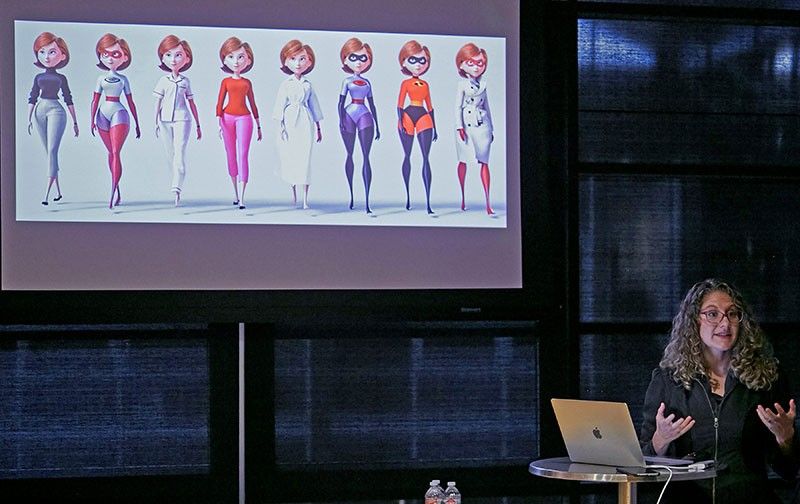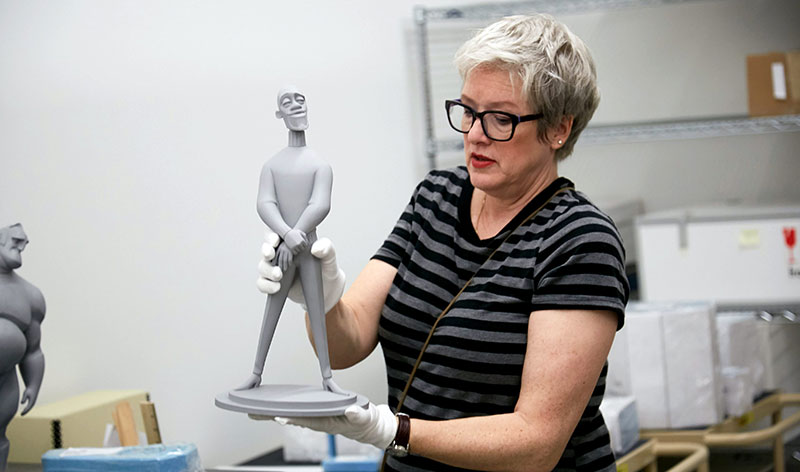A really incredible journey into Pixar

The movies of Pixar are sleek things, full of bright, snappy design, memorable characters and witty banter. They are carefully built to entertain millions, and it’s a rare thing to get a look under the hood, so to speak, at what makes Pixar run so well.
And that’s exactly where we found ourselves, crossing the 15-acre campus of Pixar Animation Studios in Emeryville, California, to sit with the designers, artists, animators, computer jockeys and director behind the upcoming Incredibles 2 and get a closer look at the Pixar magic.
And it is magic. Because magic takes lots and lots of practice and preparation. So as we media guests enter the newish Steve Jobs Building, which houses artist workspaces, conference rooms, a café and lounge and three screening rooms for some 600 employees, we prepare to be amazed.
The Incredibles 2 comes 14 years after director Brad Bird first introduced the Parr family — Bob and Helen and their kids Violet, Dash and baby Jack-Jack — to critical and box office acclaim. We settle in to watch 30 minutes of pulse-pounding new footage (“Runaway Train”) that shows the Parr family with new responsibilities, new gadgets and new powers.
It’s paired with the opening Pixar short Bao, developed in-house by young design artist Domee Shi, who turned elements of her Chinese mom’s life in Toronto into a touching (if slightly creepy) take on The Gingerbread Man. Pixar short features tend to push the envelope of animation technology, lighting and artistic shading and Bao shows how an empty nester Chinese mom creates her own new “baby” — a dumpling that comes alive and develops its own appetites and needs, which she is happy to serve. Shi says the story germ came from a joke her mom used to make when she was a kid (“I wish I could put you back in my stomach”). Pixar threw its whole team into making Bao come alive.
What does it take to turn storyboards and initial drawings into Pixar magic? There are many steps. It starts with an army of storyboard artists — different teams for different projects — coming up with sketches, colored paintings, sometimes done on tablets and devices. The drawings follow either a rough or finished script as a guide, and become the initial concept drawings for the final storyboards — often color-coded to suggest the mood of each scene.
All this pre-work then has to be rendered into the 3D world of computer animation. This means other teams create movable clay sculptures of each character (called maquettes), which the computers then scan (or geometrically map) and turn into three-dimensional models that can be moved about onscreen.
But really, that’s only the first baby steps: backgrounds have to be designed, rendered by computer to accommodate 3D geometry and action; houses have to constructed, as well as furniture for each room; then layers and layers of detail — skin, clothing, textures, lighting and shading, special effects like smoke and water, meticulous sound editing — are added, requiring even more teams to map out with incredible precision what all Pixar artists refer to in hushed tones as “The World.”

Lead archivist/Pixar historian Christine Freeman shows us the Frozone maquette. Inside the archive, you’ll see aisle after aisle of stored drawings, paintings, props, models and press clippings.
For Incredibles 2, the teams had the luxury of an existing world to build on — this is a sequel, after all. So the bigger challenge was topping the original look with new technology.
One improvement, according to effects supervisor Bill Watral, is the ability to draw changes right onto the frame on a tablet or pad. These line drawings can then be incorporated into successive frames. It’s a lot faster than a past system involving scanning each drawing, or starting the scene from scratch. Adds supervising animator Tony Fucile: “We have all these super-cool sculpting tools now that sculpt the surface of that geometry to match the original outline drawing.”
Pixar artists rely on an array of “mood boards” — at least that’s what they look like — as artists map out the physical behavior of water, smoke, motorcycles and the human body in each scene through video loops and images they’ve researched online.
Elastigirl’s new motorbike — which uncouples to match her stretchy body, allowing her to hop from building to building — is inspired by a variety of sources: everything from motorcycle design to various forms of extreme sports like waterboarding, motocross and Parkour to show off the limits of bodily behavior. Animators need to map out completely believable movement onscreen — even if it is Elastigirl doing the moving — and that’s where various videos provide visual cues as to how things actually move.
Another upgrade had to do with Jack-Jack, the superbaby whose powers now include turning into a human pyro. That caused Pixar artists much consternation, because they had to make sure the infant looked like he was “lit from within” — not smoking or burning, which would be quite disturbing. Another nagging detail that caused director Brad to scrap already completed work was the look of the Parr family’s new Frank Lloyd Wright-inspired home. “Everything revolves around story,” says sets supervisor Nathan Fariss. “If the story changes, we have to redesign from scratch.” We also learn from visual designer Philip Metschan how each stick of furniture is carefully selected from ‘50s catalogues, design books and period movies to suggest something “futuristic” — from a 1950s perspective.
And where would the Incredibles be without their superhero costumes? We learn how meticulous Pixar is about its fashion, even in an animated movie. Tailoring lead Fran Talal and shading art director Bryn Imagire share how they came up with a new line of wardrobes for cartoon couturier Edna Dash (voiced by director Bird in the film) and new character Evelyn Deavor (Catherine Keener). “We asked ourselves, what if Edna had her own designer label?” says Kalal. We’re shown an impressive array of Edna’s new outfits — inspired by elements of nature like conch shells, sculpture and even snakeskin. The look of her counterpart, Evelyn, was inspired by “boho fashion” — Yoko Ono, Patti Smith, Annie Lennox, Diane Keaton. The result is an attention to detail that “raises the bar of fashion in CG.”
A sign of how committed these Pixar artists are to “The World” they’re creating shows up in the smallest details, things your mind only picks up subconsciously. In many CG cartoons these days, you may notice, exteriors of buildings, rooms and even dusty old towns, look scrubbed clean, barely lived-in at all. It can seem very artificial. Not so with Pixar. Even the swimming pool at the Parrs’ new Cliffside home has a few random leaves floating around in it. Because the pool cleaner had the day off, maybe. Just like in real life.















